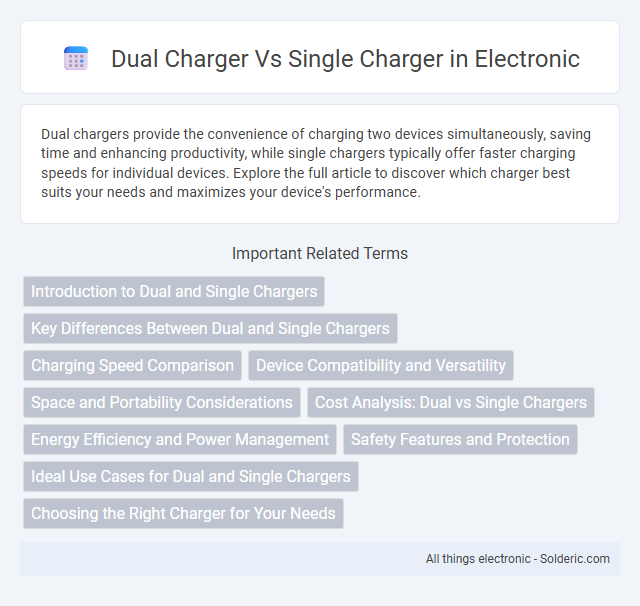Dual chargers provide the convenience of charging two devices simultaneously, saving time and enhancing productivity, while single chargers typically offer faster charging speeds for individual devices. Explore the full article to discover which charger best suits your needs and maximizes your device's performance.
Comparison Table
| Feature | Dual Charger | Single Charger |
|---|---|---|
| Charging Ports | Two ports for simultaneous charging | One port for single device charging |
| Charging Speed | Faster with two devices charging simultaneously | Optimized for one device, standard speed |
| Convenience | Charges multiple devices at once | Limited to one device at a time |
| Portability | Bulkier due to extra charging port | More compact and lightweight |
| Cost | Generally higher due to additional features | Typically lower priced |
| Use Case | Ideal for multi-device users | Best for single device users |
Introduction to Dual and Single Chargers
Dual chargers offer the convenience of charging two devices simultaneously, improving efficiency and reducing downtime compared to single chargers, which only power one device at a time. These chargers often support faster charging speeds and accommodate various device types, making them ideal for users with multiple gadgets. Your choice between dual and single chargers depends on your device usage habits and the need for charging speed and flexibility.
Key Differences Between Dual and Single Chargers
Dual chargers offer the capability to charge two devices simultaneously, increasing efficiency and reducing overall charging time, while single chargers support charging only one device at a time. Dual chargers typically come with multiple ports, such as USB-A and USB-C, enabling compatibility with a wider range of devices and faster charging speeds due to higher power output. Single chargers are generally more compact and affordable but lack the convenience and versatility provided by dual charging technology.
Charging Speed Comparison
Dual chargers provide significantly faster charging speeds by simultaneously delivering power to multiple devices, reducing overall charge time compared to single chargers. Single chargers, limited to one output, charge devices sequentially, which can extend the wait time when multiple gadgets are involved. You can enhance your charging efficiency by choosing a dual charger that supports higher wattage and multiple ports.
Device Compatibility and Versatility
Dual chargers support multiple devices simultaneously, offering compatibility with various brands and models, including smartphones, tablets, and wearable gadgets, making them ideal for versatile charging needs. Single chargers typically focus on one device or a specific brand, limiting your options and requiring multiple chargers for different devices. Choosing a dual charger enhances convenience and efficiency by powering multiple gadgets without compromising device compatibility.
Space and Portability Considerations
Dual chargers offer enhanced convenience by allowing simultaneous charging of multiple devices without increasing overall device count, yet they typically occupy more space due to their larger size and extra ports. Single chargers are more compact and lightweight, making them ideal for minimalistic setups or travel where portability is critical. Evaluating user needs for device quantity and available space ensures optimal charger selection balancing functionality and portability.
Cost Analysis: Dual vs Single Chargers
Dual chargers typically incur higher upfront costs compared to single chargers due to additional hardware components and increased complexity. However, dual chargers can reduce long-term expenses by enabling simultaneous device charging, improving efficiency, and minimizing downtime in high-demand environments. Single chargers remain cost-effective for minimal charging needs, but dual chargers provide better value in scenarios requiring frequent or multiple device charges.
Energy Efficiency and Power Management
Dual chargers offer enhanced energy efficiency by distributing power load evenly between two units, reducing overall energy consumption and optimizing power management. They minimize heat generation and prevent overloading, prolonging charger lifespan and maintaining stable performance. Your devices benefit from faster, safer charging cycles, ensuring reliable energy use compared to single charger setups.
Safety Features and Protection
Dual chargers often incorporate advanced safety features such as over-current protection, short-circuit prevention, and temperature regulation to safeguard both the charging device and batteries simultaneously. Single chargers typically offer basic protection mechanisms, but may lack the comprehensive monitoring systems found in dual chargers that reduce risks of overheating and voltage fluctuations. Ensuring your charging setup includes reliable safety protections is crucial to prevent damage and extend the lifespan of your electronic devices.
Ideal Use Cases for Dual and Single Chargers
Dual chargers excel in scenarios requiring simultaneous charging of multiple devices, such as family road trips, office desks, or tech-heavy workstations, providing convenience and time efficiency. Single chargers are ideal for individual users, minimalist setups, or travel situations where space and weight are concerns, offering targeted power delivery for one device at a time. Both charger types cater to specific needs based on device quantity, portability, and usage frequency, optimizing user experience and power management.
Choosing the Right Charger for Your Needs
Selecting the right charger depends on your device usage and charging speed preferences; dual chargers offer the advantage of charging two devices simultaneously, making them ideal for multitaskers or families. Single chargers typically provide faster charging to one device, ensuring efficient power supply without sharing output, suitable for users prioritizing speed. Evaluate your daily device load and convenience needs to decide between dual chargers for versatility or single chargers for optimized performance.
dual charger vs single charger Infographic

 solderic.com
solderic.com